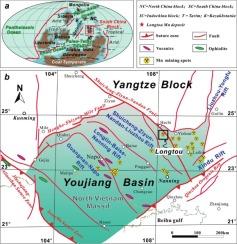Genesis of the carboniferous Longtou manganese deposit, central Guangxi, SW China: insights from mineralogy, geochemistry, and carbon isotopes
IF 3.6
2区 地球科学
Q1 GEOLOGY
引用次数: 0
Abstract
Marine sedimentary manganese deposits can be divided into two types based on their host rock: black shale-hosted and carbonate rock-hosted. In contrast to black shale-hosted deposits, carbonate rock-hosted Mn deposits exhibit significant differences in lithology and geochemical composition. Moreover, the precipitation mechanisms and mineralization processes of Mn in carbonate rock-hosted deposits remain a subject of ongoing debate. Central Guangxi is a relatively developed area of carbonate rock-hosted Mn ores, with Longtou Mn deposit as one of the typical representatives, which develops multilayered ore bodies with well-preserved ore textural features. This study focuses on the sedimentology, mineralogy, elemental geochemistry, and carbon isotope, aiming to elucidate the sedimentary mineralization process and its key controlling factors. The primary Mn ore bodies with industrial value in the Longtou deposit mainly have four layers (numbered as I, II, III, and IV), all predominantly hosted in the Lower Carboniferous Baping Formation limestone and chert-bearing limestone. The primary Mn-bearing ores include calcium rhodochrosite, kutnohorite, Mn-calcite, and Mn oxides. Layer I is characterized by well-developed concentric ring structures, primarily composed of kutnohorite, dolomite, and calcite-rich rhodochrosite. In contrast, layer II, III, and IV exhibit a higher abundance of calcium rhodochrosite, kutnohorite, and braunite, with minerals frequently displaying interlocking textures or replacement relationships. The Mn ores exhibit a visible assemblage of acicular pyrophanite, scheelite, and rhodonite. Combined with geochemical parameters such as Y/Ho, and the triangle diagram 10×(Ni + Co + Cu)-Fe-Mn, 100×(Zr + Ce + Y)-15×(Cu + Ni)-(Fe + Mn)/4, these characteristics suggest that submarine hydrothermal activity provided an important material foundation for the mineralization of the Mn ores. Through a comprehensive analysis of lithofacies, δ13CV-PDB values, total organic carbon (TOC) content, and Ce anomalies, the study suggests potential differences in mineralization mechanisms and processes between the ore layer I and ore layer II, III, and IV. It is proposed that layer I was formed through the upwelling of Mn-rich, anoxic waters into the shallow-water zone, which markedly changed the redox conditions and promoted the precipitation of Mn minerals. This shift also introduced additional dissolved inorganic carbon and nucleation sites for crystal growth, leading to the formation of Mn carbonates with calcite/dolomite cores. Subsequently, as the environmental conditions gradually shifted toward a more oxidizing state, the dissolved Mn2+ in layer II, III, and IV was predominantly precipitated as Mn oxides. These oxides were then reduced by organic matter, forming Mn carbonates. These understandings offer valuable insights into the sedimentary Mn carbonate mineralization process in carbonate rock-hosted deposits and contribute to the broader development of theoretical frameworks for sedimentary Mn carbonate deposit formation.

广西中部石炭系龙头锰矿床成因:矿物学、地球化学和碳同位素的启示
海相沉积锰矿根据其寄主岩可分为黑色页岩型和碳酸盐岩型两种类型。与黑色页岩矿床相比,碳酸盐岩锰矿床在岩性和地球化学组成上存在显著差异。此外,碳酸盐岩矿床中Mn的沉淀机制和成矿过程仍然是一个争论不休的话题。桂中地区是碳酸盐岩型锰矿较为发达的地区,龙头锰矿为典型代表,矿体发育多层,矿石结构特征保存较好。本文从沉积学、矿物学、元素地球化学、碳同位素等方面进行研究,旨在阐明沉积成矿过程及其关键控制因素。龙头矿床具有工业价值的原生锰矿体主要有1、2、3、4层,主要赋存于下石炭统巴坪组灰岩和含燧石质灰岩中。原生含锰矿石包括钙菱锰矿、钾锰矿、锰方解石和锰氧化物。第一层为发育良好的同心圆状构造,主要由库氏石、白云石和富方解石的菱锰矿组成。相比之下,第2层、第3层和第4层显示出更高丰度的钙红锰矿、钾锰矿和钙锰矿,矿物经常显示连锁结构或替代关系。锰矿具有明显的针状辉磷矿、白钨矿和菱铁矿组合。结合地球化学参数Y/Ho和10×(Ni + Co + Cu)-Fe-Mn、100×(Zr + Ce + Y)-15×(Cu + Ni)-(Fe + Mn)/4三角图,表明海底热液活动为Mn矿化提供了重要的物质基础。通过岩相、δ13CV-PDB值、总有机碳(TOC)含量、Ce异常等综合分析,认为ⅰ层与ⅱ、ⅲ、ⅳ层矿化机制和过程存在潜在差异。认为ⅰ层是富锰缺氧水上涌至浅水区形成的,明显改变了氧化还原条件,促进了Mn矿物的沉淀。这种转变还引入了额外的溶解无机碳和晶体生长的成核位点,从而形成了具有方解石/白云石岩心的锰碳酸盐。随后,随着环境条件逐渐向氧化态转变,溶解在第II层、第III层和第IV层的Mn2+主要以Mn氧化物的形式析出。这些氧化物随后被有机物还原,形成碳酸锰。这些认识为碳酸盐岩矿床的沉积型碳酸锰矿化过程提供了有价值的见解,并有助于更广泛地发展沉积型碳酸锰矿床形成的理论框架。
本文章由计算机程序翻译,如有差异,请以英文原文为准。
求助全文
约1分钟内获得全文
求助全文
来源期刊

Ore Geology Reviews
地学-地质学
CiteScore
6.50
自引率
27.30%
发文量
546
审稿时长
22.9 weeks
期刊介绍:
Ore Geology Reviews aims to familiarize all earth scientists with recent advances in a number of interconnected disciplines related to the study of, and search for, ore deposits. The reviews range from brief to longer contributions, but the journal preferentially publishes manuscripts that fill the niche between the commonly shorter journal articles and the comprehensive book coverages, and thus has a special appeal to many authors and readers.
 求助内容:
求助内容: 应助结果提醒方式:
应助结果提醒方式:


